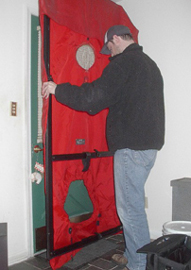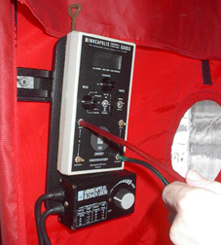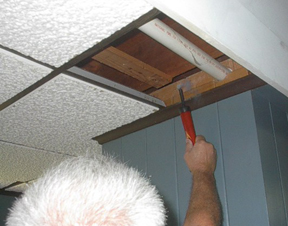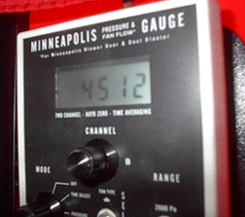Most heating and cooling contractors have some familiarity with the blower door device - that big fan the weatherization guys and insulators plug into the doorway that sucks air from a home in order to find leaks. But even fewer have one hanging among the refrigeration gauges, B-tank, and other staples of the trade.
Since its introduction to the United States in the late 70s, use of blower doors has been confined largely to building science researchers, utility-sponsored weatherization programs, and a few enlightened insulators. While only a fraction of United States heating and cooling contractors actively use blower doors in the field, they're a common tool among many of our European trades counterparts.
If you've read the occasional trade article espousing the benefits of blower door testing, and have always thought that the blower door just wasn't for you, maybe it's time to give it a second look. The benefits of blower door testing are multifold, and the contractors that have adopted its use are employing it in a variety of creative, valuable ways to strengthen the bottom line and improve quality of service to their customers.
Some HVAC outfits now offer energy audits, or comprehensive whole-house assessments as an additional stream of income. For typical homes, energy audits that include blower door testing usually take 30 minutes to three hours, with many contractors charging prices as low as free (as part of an estimate), or has high as $1,000, depending on the market, additional procedures performed, the depth of analysis, or whether specialized software modeling and/or detailed reporting is involved.

|
| Figure 1. To blower door test, a foldable frame clamps an airtight shroud into a home’s exterior doorway. |
When offering a comprehensive, well-rounded energy audit to customers, many professionals conduct several standard procedures that include:
Blower door testing to measure air-leakage rates; determine mechanical ventilation requirements; and identify leakage and weakness in the thermal envelope that, if addressed, could result in energy savings, improved air quality, or avert mold and moisture damage.
Combustion safety testing, including a procedure called worst-case CAZ (combustion appliance zone) depressurization, that involves depressurizing the house with its existing exhaust appliances (i.e., exhaust fans and laundry dryers) to create a worst-case negative-pressure condition. While under worst-case conditions, one tests the combustion appliances' ability to draft safely. Carbon monoxide analysis and draft and spillage tests on combustion appliances are also performed.
Visual inspections of insulation levels, unique building features, and obvious problems with heating and cooling systems, such as leaky or broken ductwork. The total air volume of the home is also measured to later determine its air changes per hour.
Static pressure tests on ductwork to provide a quick and simple method to identify compromises in the air-distribution system. High static pressure readings typically indicate restrictions in airflow that lead to underperformance and efficiency losses.
Software modeling, including Manual J calculations using the data collected in the home. Many heat-load software packages include energy analysis features that help customers weigh cost versus benefits of energy-efficiency upgrades, such as heating or cooling system replacements.

|
| Figure 2. An elasticized cutout in the blower door’s shroud fits around a large exhaust fan. |
If you don't plan to offer energy audits as a standalone service, blower door testing, and a well-rounded arsenal of other diagnostic procedures, can be integrated into the work you already do - increasing sales, improving performance on new installations, reducing callbacks, and protecting you from costly liabilities.
Pointing out the sources of drafts and leaks, and the ability to quantify them in terms of actual dollars lost, is a powerful tool in any sales situation. With blower door testing, you're no longer going to claim energy savings, you're going to measure it. Additionally, the blower door helps uncover hidden problems that normally go unnoticed by other contractors, which provides more opportunities to offer solutions and increase sales.
Knowing a home's leakage rate improves the accuracy of heating-load calculations, ensuring properly sized equipment and optimum long-term performance. And instead of selling bigger appliances, sell smaller ones. By identifying problems with insulation or air leakage, and facilitating their repair and improvement, heating loads can be reduced. This gives homeowners an opportunity to downsize equipment and lower the cost of replacement.
And if a customer should complain of being too cold or too hot - and you know you've sized the appliance right - a blower door test can show the homeowner that they've been a victim of air leaks or shoddy insulation, not an undersized HVAC system.

|
| Figure 3. A rubber hose connects the pressure/flow sensors in the blower to a handheld manometer. |
HOW TO BLOWER DOOR TEST
Basic blower door testing is a relatively easy affair. A foldable, usually metal, frame clamps an airtight shroud into a home's exterior doorway (Figure 1). An elasticized cutout in the shroud fits around a large exhaust fan (Figure 2) that's outfitted with a variable-speed controller and small, barbed rubber-hose connections for the built-in pressure and flow sensors.
A small rubber hose connects the pressure/flow sensors in the blower to a handheld manometer (Figure 3). A second hose connects the manometer to the outside.
To get a whole-house air leakage reading, first a base pressure reading is taken, measuring the pressure difference between the inside of the house (at the blower door location) and the outside. All windows and doors should be closed, as well as the fireplace damper to prevent soot from being sucked into the room. All combustion appliances should be turned off to avoid back drafting.
Noting the base pressure readout in the manometer, the blower is then turned on (fan should be pointed to the outside) to create a negative pressure 50 pascals (Pa) below the base pressure.

|
| Figure 4. A smoke puffer may be used to reveal and trace air movement. |
Note: Manometers for blower doors often express pressure readings in terms of pascals (Pa). One Pa is equal to approximately 0.004 inches of water column.
Once the house is fully depressurized to -50 Pa, make-up air equivalent to the force of a 20 mph wind will force its way in through the leaks, cracks, and gaps of the home.
With the blower door running, a walk around the home will help reveal sources and locations of major air leaks. A smoke puffer (Figure 4) can be used to reveal and trace air movement.
The manometer is then switched from the pressure reading display to the flow reading setting. The flow reading setting will provide the home's overall air leakage rate (Figure 5), expressed in cubic feet per minute (cfm). If the home's volume is known, this reading can then be quickly converted from cfm - of natural ventilation - to air changes per hour (ACH), which is used to determine the home's mechanical ventilation requirements.

|
| Figure 5. The manometer’s flow reading setting will provide the home’s overall air leakage rate. |
HOW TO GET STARTED
A blower door testing device with a digital manometer can set a contractor back well over $2,500. Throw in a combustion gas analyzer, another manometer, and a few other toys, and you'll be out at least $5,000. Though they may be among the most expensive tools in your van, they're certainly the most valuable.
Some state energy agencies and gas and electric utilities offer a variety of energy-efficiency programs aimed at trade contractors. In addition to providing technical training, some programs offer generous equipment purchasing and leasing programs.
In New York, for example, the Home Performance with Energy Star program (www.getenergysmart.org), the state's utility ratepayer-funded energy-efficiency program, offers an equipment "forgiveness" clause to contractors' participation agreements. Contractors that conduct a specified number of "comprehensive home assessments," or energy audits, through the program are relieved of a significant portion of their loan obligations on purchased equipment.
A directory of training programs is available from the Residential Energy Services Network (RESNET) Website (www.natresnet.org).
Training courses and equipment are also available through blower door manufacturers directly, as well as trade organizations, such as the National Comfort Institute (www.nationalcomfortinstitute.com).
Sidebar: Five Must-Have Tools For Smart HVAC Pros
1. Manometer: Whether it's an affordable, tried-and-true analog, or a pricier multi-function digital model, manometers are one of the most versatile testing tools in your arsenal. Among their many functions, manometers can be used to check draft on combustion appliances, take static pressure readings on duct systems, and measure house pressures in whole-house audits.
2. Manual-J software: Rule-of-thumb heat-load methods often lead to equipment oversizing that robs the effectiveness of your installations. From appliance sizing to designing distribution systems, Manual-J software is critical to getting your install right - the first time. Several software makers offer robust, bundled packages that include useful tools and features that can take your entire HVAC project from point-of-sale to final commissioning.
3. Laptop computer: Heat-load calculations, radiant design software, duct calculators, in-home sales presentations, data logging - laptops are as invaluable in the field as in the office.
4. Blower door device: Use of blower doors among Americans has been largely confined to the weatherization/energy auditing crowd. By measuring a building's actual leakage rate (air changes per hour), contractors can calculate loads more accurately, determine proper mechanical ventilation needs, and point out thermal weaknesses in the building envelope. Have you ever been called back because a shoddy insulation job left your customer cold? Blower doors end finger pointing.
5. Combustion gas analyzer: You simply can't tune appliances without them. If you're not testing, you're only guessing. In the realm of combustion safety, one bad guess can lead to unthinkable catastrophe. If there's only one of these tools you can have, this is the one.
Raised in the contracting environment since birth, John Bishop is vice president of Enhanced Living Inc. (www.enhancedliving.net), his family's HVAC contracting and building science consultancy based in Troy, N.Y. With extensive experience in building science, public policy, and marketing, he was formerly the state marketing coordinator for New York's Home Performance with Energy Star and Energy Star Labeled Homes programs. He also served as press secretary to U.S. Rep. John E. Sweeney (R-N.Y.). Bishop can be contacted at johnbishop@enhancedliving.net.
Publication date: 01/23/2006





